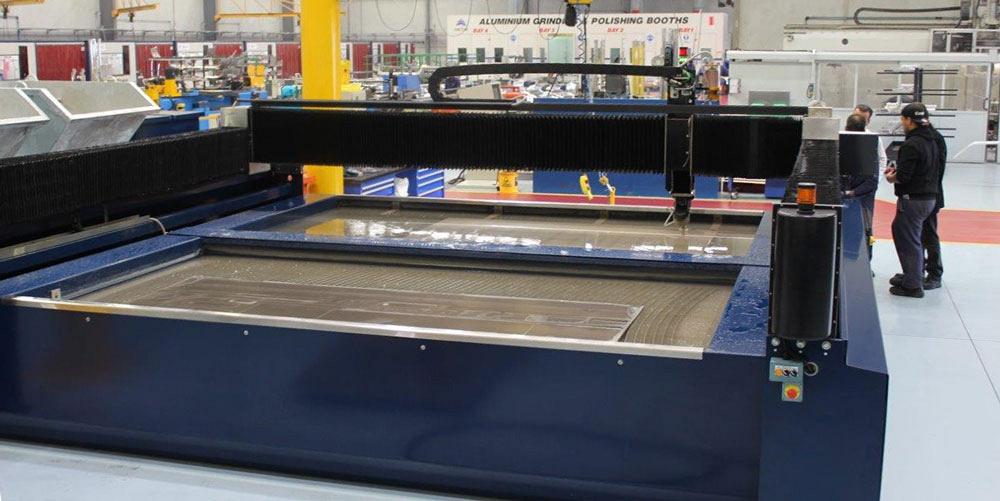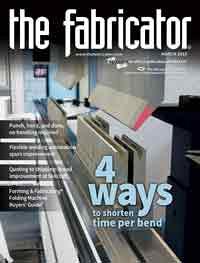Editor-in-Chief
- FMA
- The Fabricator
- FABTECH
- Canadian Metalworking
Categories
- Additive Manufacturing
- Aluminum Welding
- Arc Welding
- Assembly and Joining
- Automation and Robotics
- Bending and Forming
- Consumables
- Cutting and Weld Prep
- Electric Vehicles
- En Español
- Finishing
- Hydroforming
- Laser Cutting
- Laser Welding
- Machining
- Manufacturing Software
- Materials Handling
- Metals/Materials
- Oxyfuel Cutting
- Plasma Cutting
- Power Tools
- Punching and Other Holemaking
- Roll Forming
- Safety
- Sawing
- Shearing
- Shop Management
- Testing and Measuring
- Tube and Pipe Fabrication
- Tube and Pipe Production
- Waterjet Cutting
Industry Directory
Webcasts
Podcasts
FAB 40
Advertise
Subscribe
Account Login
Search
Two tanks for waterjet productivity
A dual-tank system eliminates waterjet downtime
- By Dan Davis
- April 29, 2015
- Article
- Waterjet Cutting

This dual-tank waterjet system is designed to accommodate continual cutting while minimizing quality issues related to dropped parts during unloading.
What is good for one large-volume fabricator of waterjet-cut parts is good for others.
That’s what TECHNI Waterjet™ has learned after developing a waterjet cutting machine for a high-volume production environment. The dual-tank system with one bridge and cutting head proved to be such a success for the high-volume application that the waterjet manufacturer rolled it out as a standard product.
“A lot of people will build a tank with one work zone, or you might have dual work zones on the same large tank,” said Jim Fields, national sales manager, TECHNI Waterjet. “With this approach—the dual independent tanks—the fabricator can be cutting in one work envelope while offloading and reloading in the other work envelope.”
Admittedly, a fabricator also can unload parts on a large table with dual work zones. But Fields said that the independent tanks help to maintain cut quality, in addition to boost productivity, because when a large part is dropped on the slats of one tank, it will not disrupt the cutting taking place on the other tank, as might occur on a single-tank table. Considering this waterjet can cut material up to 8 in. thick, it’s entirely possible that an operator will mishandle a large part during unloading. It’s a real-world production reality.
“It is actually good for safety as well,” Fields added. “There are limit switches that keep personnel out of the secondary work zone until the program is finished.
“Then, once the alarms are cleared and the waterjets shift to the next work zone, you can go into the other work zone, unload, and reload the table while the cutting head is at work on the other tank.”
Fields said that this approach to machine design is suitable for those fabricators interested in maximizing cutting productivity. With the i713-G2 Dual Station waterjet, continuous production is the norm. When the machine is running, the fabricator knows that it is making money, Fields said.
The new machine has two 7- by 13-foot tanks for a total cutting area of 14 by 26 ft. (Larger tanks can be added to the system, and additional cutting heads can be added to the bridge.) Bevel cutting is possible on this machine as it comes with a PAC 60™ 5-axis cutting head for up to ±60 degrees of continuous rotation with taper elimination.
The dual-tank waterjet is equipped with a water-raise-and-lower function for submerged cutting. This feature reduces the splash that might send water flying from the tank as the waterjet hits a slat. Because the cutting takes place underwater, these collisions of the waterjet stream and the slats are minimized, keeping the water in the tank. Fields added that the submerged cutting feature also helps to produce a higher-quality cut because the waterjet stream is not affected by air. In above-water cutting, the waterjet stream starts to diffuse the minute it is exposed to the air. With the stream underwater, the jet maintains its consistent characteristics from the time it leaves the nozzle until the time it cuts the part. Air is unable to change the stream’s characteristics.
The waterjet also comes with the Quantum NXT™ 66 Dual pump, which is designed to operate at less than 68 dBA, and the Tech-Sense™ abrasive monitoring system. The entire machine is designed to be run by one operator.
Fields said that this type of machine can make a big impact on a shop looking for more productivity from its cutting operations. It may not be able to match the performance of a laser cutting machine working with thin metals, but the conversation becomes more interesting for those shops working with a variety of metals that are mostly 0.25 in. or thicker. The nonthermal cutting characteristics of the waterjet do not change the raw material because no heat-affected zone is created during the cutting process, and the method is able to make a smooth cut edge.
“These added features and dual-zone cutting areas have made waterjets a very high-production machine for fabricators,” Fields said.
About the Author

Dan Davis
2135 Point Blvd.
Elgin, IL 60123
815-227-8281
Dan Davis is editor-in-chief of The Fabricator, the industry's most widely circulated metal fabricating magazine, and its sister publications, The Tube & Pipe Journal and The Welder. He has been with the publications since April 2002.
Related Companies
subscribe now

The Fabricator is North America's leading magazine for the metal forming and fabricating industry. The magazine delivers the news, technical articles, and case histories that enable fabricators to do their jobs more efficiently. The Fabricator has served the industry since 1970.
start your free subscription- Stay connected from anywhere

Easily access valuable industry resources now with full access to the digital edition of The Fabricator.

Easily access valuable industry resources now with full access to the digital edition of The Welder.

Easily access valuable industry resources now with full access to the digital edition of The Tube and Pipe Journal.
- Podcasting
- Podcast:
- The Fabricator Podcast
- Published:
- 04/30/2024
- Running Time:
- 53:00
Seth Feldman of Iowa-based Wertzbaugher Services joins The Fabricator Podcast to offer his take as a Gen Zer...
- Industry Events
16th Annual Safety Conference
- April 30 - May 1, 2024
- Elgin,
Pipe and Tube Conference
- May 21 - 22, 2024
- Omaha, NE
World-Class Roll Forming Workshop
- June 5 - 6, 2024
- Louisville, KY
Advanced Laser Application Workshop
- June 25 - 27, 2024
- Novi, MI































